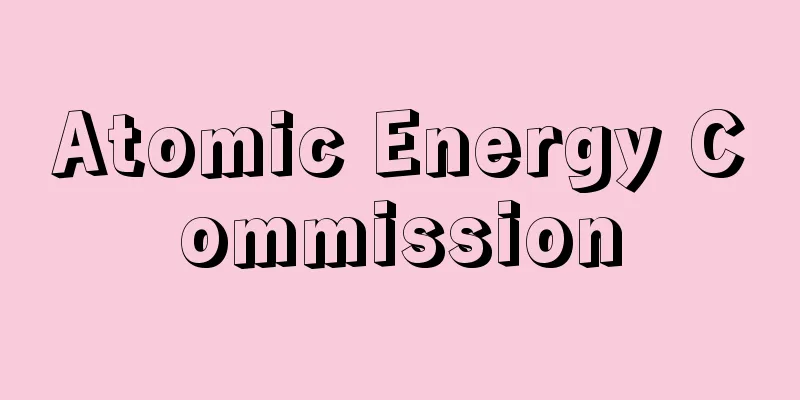Atomic Energy Commission

|
The first organization named the Atomic Energy Commission appeared in the United Nations in January 1946, just after the Second World War, with the objective of controlling the military use of atomic energy and promoting its peaceful development. However, the organization ceased operations in July 1947, and was absorbed into the United Nations Disarmament Commission (now the Conference on Disarmament) in January 1952. [Atsunosuke Nakajima] United States Atomic Energy CommissionIn the United States, the Atomic Energy Commission was established based on the Atomic Energy Act (McMahon Act) enacted in 1946. During World War II, atomic energy development, which was under the control of the Army, was transferred to the Atomic Energy Commission, with D. Lilienthal as its first chairman, on January 1, 1947, and it came under civilian control. However, until 1954, when the United States changed its nuclear policy and adopted the "Atoms for Peace" policy, the Atomic Energy Commission's activities were concentrated on its role as an arms manufacturing organization for the development of nuclear weapons, even though it was under civilian control. For the first time since 1954, it has acted as a powerful administrative commission that provides research and development, subsidies, and safety regulations for peaceful uses such as nuclear power generation. At the same time, the United States promoted the conclusion of bilateral agreements on the peaceful use of atomic energy with countries around the world, and Atomic Energy Commissions were established in each country. In the United States, the safety regulation department was separated into the Nuclear Regulatory Commission (NRC) in 1975, and the development department became the Energy Research and Development Administration (ERDA), but was later absorbed into the newly established Department of Energy. [Atsunosuke Nakajima] Japan Atomic Energy CommissionJapan's Atomic Energy Commission was established in January 1956 in the former Prime Minister's Office, based on the Atomic Energy Basic Act (Act No. 186 of 1955), with the objectives of systematically implementing national policies related to the research, development and utilization of atomic energy, and promoting democratic administration of atomic energy administration. In October 1978, the Nuclear Safety Commission, which was responsible for safety regulation administration, was separated and became independent. Later, in January 2001, as part of the reorganization of central government ministries and agencies, the Prime Minister's Office was reorganized and integrated to form the Cabinet Office, and the Atomic Energy Commission was transferred to the Cabinet Office. The Atomic Energy Commission is legally an Article 8 organ of the Administrative Law (a part of the administrative organ established under Article 8 of the National Government Organization Law, whose report must be consistent with that of the government ministries and agencies), but it is not merely an advisory body, but is in effect the highest responsible body for research, development, and promotion of peaceful uses of atomic energy, as its recommendations must be respected by the Prime Minister and it can make recommendations to the heads of relevant agencies through the Prime Minister. Until the reorganization of the central government ministries and agencies, the chairman of the Atomic Energy Commission was the Minister of State who also served as the Director-General of the Science and Technology Agency, but after the transfer to the Cabinet Office, this position was filled by an academic and experienced person. The chairman and four members are appointed by the Prime Minister with the consent of the Diet. The Commission is to set up various expert committees on important research and development and policies to carry out investigations and deliberations, and to reflect the results in the "Long-term Plan for Atomic Energy Development and Utilization," which was revised roughly every five years until 2000. From the 2005 version onwards, the name was changed to "Nuclear Energy Policy Principles," and plans were to be drawn up with a target period of around 10 years, but responsibility was transferred to the Nuclear Safety Commission (since 2012, the Nuclear Regulation Authority). [Atsunosuke Nakajima] [Reference items] | | | |Source: Shogakukan Encyclopedia Nipponica About Encyclopedia Nipponica Information | Legend |
|
原子力委員会という名称を冠した組織が史上最初に出現したのは、第二次世界大戦直後の1946年1月国際連合においてであって、原子力の軍事利用を管理し、平和的開発を促進することを目的としていた。しかしこの組織は1947年7月以降活動を停止し、1952年1月以降は国連軍縮委員会(現、軍縮会議)に吸収された。 [中島篤之助] アメリカの原子力委員会アメリカでは、1946年に成立した原子力法(マクマホン法)に基づき原子力委員会が設立された。第二次世界大戦中、陸軍の管理下にあった原子力開発は、1947年1月1日、D・リリエンソールを初代委員長とする原子力委員会に移管され、文民管理となった。しかし、1954年アメリカが核政策を転換し、「平和のための原子力Atoms for Peace」政策を採用するまでの期間は、文民管理とはいいながら、その活動は核兵器開発のための造兵機関としての活動に集中された。1954年以降初めて、原子力発電などの平和利用のための研究開発、助成、安全規制などを行う強力な行政委員会として活動することとなる。アメリカは同時に世界各国と原子力平和利用に関する双務協定の締結を推進したので、各国にも原子力委員会がつくられることになった。アメリカでは1975年に、安全規制部門を独立させて原子力規制委員会(NRC)を組織し、開発部門はエネルギー研究開発局(ERDA)となったが、のちに新設されたエネルギー省に吸収された。 [中島篤之助] 日本の原子力委員会日本の原子力委員会は、原子力基本法(昭和30年法律第186号)に基づき、原子力の研究・開発および利用に関する国の施策を計画的に遂行し、原子力行政の民主的運営を図る目的をもって、1956年(昭和31)1月、旧総理府に設置された。1978年10月、安全規制行政を担当する原子力安全委員会が分離独立した。その後、2001年(平成13)1月の中央省庁再編により、総理府が再編統合されて内閣府になったのに伴い内閣府に移管された。 原子力委員会は、法律上は行政法上の八条機関(国家行政組織法8条に基づいて設置された行政機関の一部で答申が省庁との整合性を要する)であるが、その勧告を総理大臣が尊重しなければならないことや、総理大臣を通じて関係機関の長に勧告しうることなど、単なる諮問機関ではなく、実質的に原子力平和利用の研究・開発および利用推進の最高責任機関となっている。原子力委員長は、中央省庁再編までは科学技術庁長官である国務大臣が兼務することとなっていたが、内閣府に移管されてからは、学識経験者が就任することになった。委員長と4人の委員は、国会の同意を得て内閣総理大臣によって任命される。同委員会は重要研究開発および政策に関する各種専門部会を設置して調査審議を進め、それを「原子力開発利用長期計画」に反映することとされ、2000年までおおむね5年ごとの改定がなされてきた。2005年策定分からは「原子力政策大綱」と名を改め、10年程度の期間を目安として計画を策定することとなったが、原子力安全委員会(2012年以降、原子力規制委員会)に移った。 [中島篤之助] [参照項目] | | | |出典 小学館 日本大百科全書(ニッポニカ)日本大百科全書(ニッポニカ)について 情報 | 凡例 |
Recommend
Saddle Nose
[What kind of disease is it?] A saddle nose is whe...
Cork (English spelling)
A special city in the southwest of Ireland, in the...
Comenius - Johann Amos Comenius
An educational thinker born in Moravia, a region ...
Flood in Edo in the 2nd year of the Kanpo era
Rain had been falling continuously since July 28, ...
Forgetting
It means being unable to recall something that yo...
Tsiolkovsky
Soviet physicist. At the age of nine, he became al...
Ebina [city] - Ebina
A city in central Kanagawa Prefecture. It was inco...
Side tunnel - Enso-kodo
A tunnel dug along a coal seam. Source: The Select...
Hollyhock (Althaea rosea) - Althaea rosea; hollyhock
A large perennial plant of the Malvaceae family, n...
Swift's scallop
A bivalve mollusca of the family Pectiniidae in t...
accommodation
…The word 'hygiene' was taken from Zhuang...
Feathered bald man
Kabuki dance. Nagauta. Lyrics by Segawa Jokou I, ...
André Malraux
French novelist and thinker. Born in Paris on Nov...
Charcoal car
〘 noun 〙 A car that runs on carbon monoxide produc...
Iseyo doodles - Iseyo doodles
…It is distributed from Hokkaido to Kyushu, the K...









